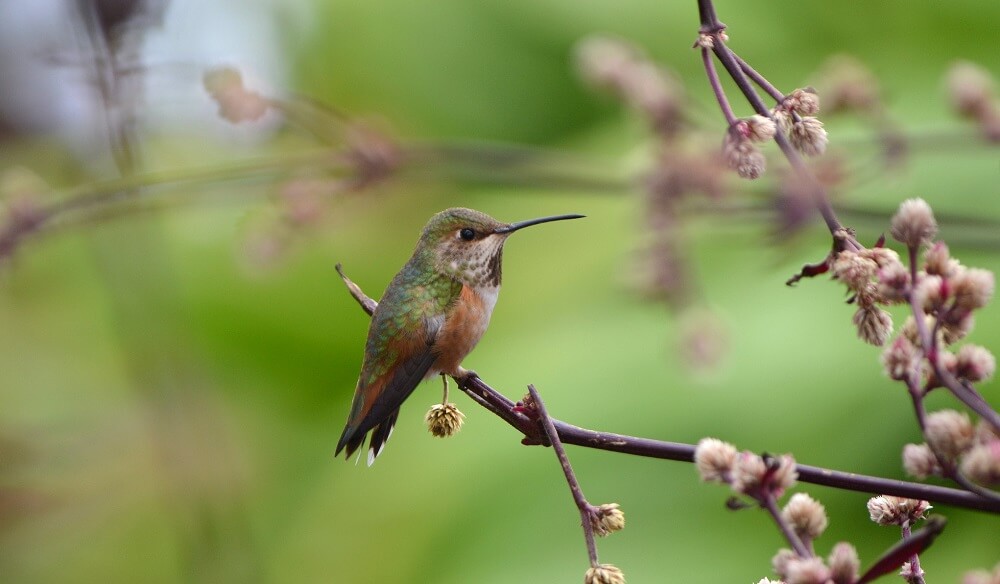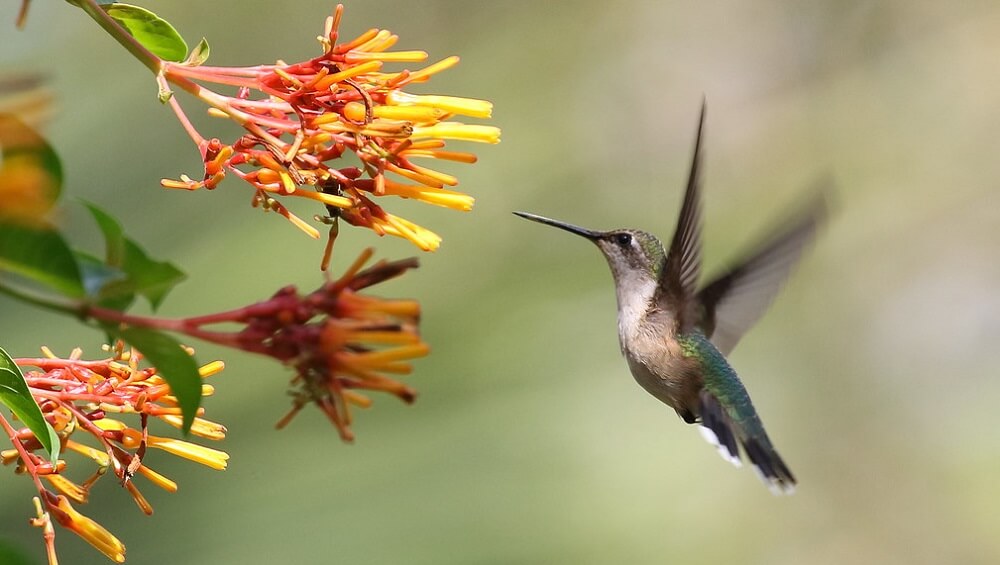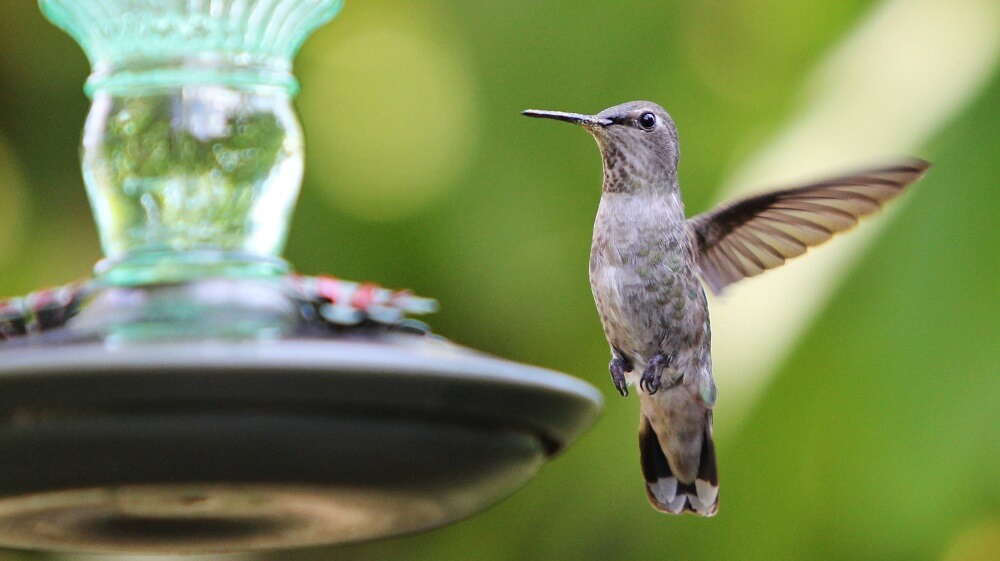Hummingbirds are delicate, graceful birds. They are lovely and fascinating to watch.
A hummingbird feeder can be a great way to get those little visitors to your yard, but if you place a feeder in the wrong place it could mean death for your local hummingbirds. It might also mean that you don’t end up attracting hummingbirds to your garden.
In Part 1, we discussed where to hang bird feeders to attract birds to your yard and garden. But, hummingbird feeders are a little different and should be placed separately from other bird feeders.
Where Should Hummingbird Feeders Be Placed?
Hummingbird feeders should be hung in an area that is safe for the small birds, visible, and high. Hummingbird feeders should not endanger the hummingbirds. They should be placed in an area that will attract hummingbirds and allow them to find your feeders.
There are a few things to keep in mind when placing hummingbird feeders.
- Place hummingbird feeders in the shade.
- Place feeders close to windows
- Place feeders in a visible area.
- Protect it from the wind
- Place feeders away from other bird feeders
- Place feeders near running water
- Place feeders by flowers
- Use the correct hummingbird feeders
Watch this video from the Smithsonian that captures hummingbirds flying in slow motion. Start at the 1:00 mark to see the slow-motion of a hummingbird flight!
Keep reading to learn the details
Place Hummingbird Feeders In The Shade
Hummingbirds love sugary foods. Hummingbird food is sweet and many people mix sugar and water for these lovely birds.
The sweet juice in hummingbird feeders rots quickly.
So, feeders should be kept in the shade.
If you can’t keep them in constant shade, then at least place them somewhere they will be shaded during the hottest parts of the day.
Don’t forget!
You should also change the nectar regularly. Every day on extremely hot days and at least every 3-5 days on cooler days.
Hummingbirds that taste rotten nectar won’t return.
Place Hummingbird Feeders Close To Windows
It’s important to place your feeders in a place that won’t cause death to your hummingbirds.
Windows are a huge cause of death. Hummingbirds are small, but they fly fast.
Place your feeders within 3 feet of a window. That way, if a hummingbird does smack into it, it won’t be flying fast enough to cause death.
Place Feeders In A Visible Area
You should also place the feeder in a visible place where hummingbirds can see it. They prefer to watch for danger while they hover for food.
And, they only perch to rest. While they perch, they watch for danger.
They also like to watch their food sources from their perching place.

Photo Credit: Flickr Tracie Hall
Place feeders in an open area where hummingbirds can see the feeder.
If it catches an occasional sunray, it will make it easier for hummingbirds to notice it.
They see in ultraviolet light so reds and purples are very visible to them.
Protect Feeders From The Wind
Hummingbirds especially don’t like strong winds. If you live in a windy area, make sure to place your feeders in an area where they will be protected from the wind.
Choose the side of your house that is facing away from the wind so that the feeders are sheltered.
Place Feeders Away From Other Bird Feeders
Hummingbirds are small birds. That means that they are often killed or eaten by larger birds.
They will shy away from areas that have a lot of birds nearby.
That’s because it’s more dangerous for them.
Hang your hummingbird feeders in an area that’s away from other bird feeders and it will be more attractive to them.
Keep Feeders Away From Predators
It’s not always possible to keep feeders away from predators, but understanding how many animals can kill hummingbirds can help you to place the feeder in safer locations.
Feeders should be away from areas where cats can climb or jump from. The should be higher above the ground and away from trees where large birds can reside.
There are many predators to hummingbirds because they are so small. Those predators include;
- Cats: The #1 predator
- Preying Matis
- Orb Weaver Spiders
- Snakes and lizards
- Frogs and some fish
- Roadrunner
- Hawks and owls
- Merlin birds
Taking precautions can keep your hummingbird visitors safe. Watch webs and nests that are built near hummingbird feeders.
Move them feeders if needed or clear away nests.
Place Feeders By Water
Hummingbirds love the sound of water. Placing your feeders in an area where they have quick access to water is helpful in attracting hummingbirds to your feeders.
If you have the ability, have a different bigger birdbath for the larger birds.
Hummingbirds don’t need a lot of water. They often drink water droplets off the leaves of trees and plants.
Place Feeders By Flowers
Many flowers will attract hummingbirds. Try planting some of these flowers to attract hummingbirds to your flower garden and help them to find your feeders.
Hummingbirds see in ultraviolet light. So bright colors are attractive to them.
They also love flowers with a lot of pollen.
Those are the ones that smell the most also!
Hummingbirds also love long flowers that accommodate their nose for the picking.
There are literally hundreds of flower varieties that hummingbirds love.

Photo Credit: Flickr Shahin Abasov
You can check out this article on How To Plant A Hummingbird Garden for a full list. Some of the most popular hummingbird flowers are:
- Trumpet vines
- Red Cardinals
- Delphiniums
- Bee Balm
- Fireweed
- Sage
- Hydrangea
- Lupine
- Lilies
- Columbine
- Most bright and nectar-rich flowers
Use The Correct Kind Of Feeders
Hummingbirds eat differently than other birds. Their long beak is ideal for extracting nectar.
Hummingbird feeders are liquid feeders made with a small port sized for hummingbird beaks.
But, they don’t see colors as we do.
Hummingbirds see in ultraviolet light and red show up nice and dark.
Red is easily a hummingbird’s favorite color.
Even though hummingbirds love red, they will come to feeders that have other colors incorporated.
They especially love the color red and are more likely to feed on a feeder with red on it.
A red feeder is more likely to attract hummingbirds.

Conclusion
Try these tips and keep hummingbirds coming to your garden and staying safe!
You might also enjoy the next article in this series How And When To Place Oriole Bird Feeders.
We have some other related articles including:
How to place finch feeders to attract finches to your yard
Where to place bluebird feeders in your garden
Where to place robbin feeders in your yard
Feature Photo Credit: Siamesepuppy Flickr

